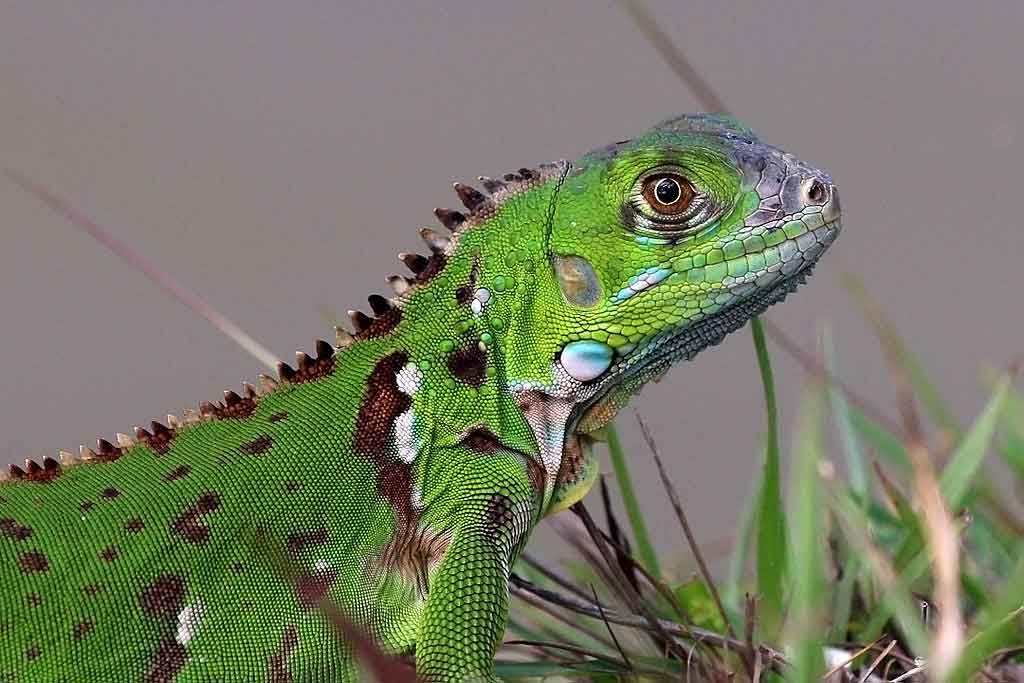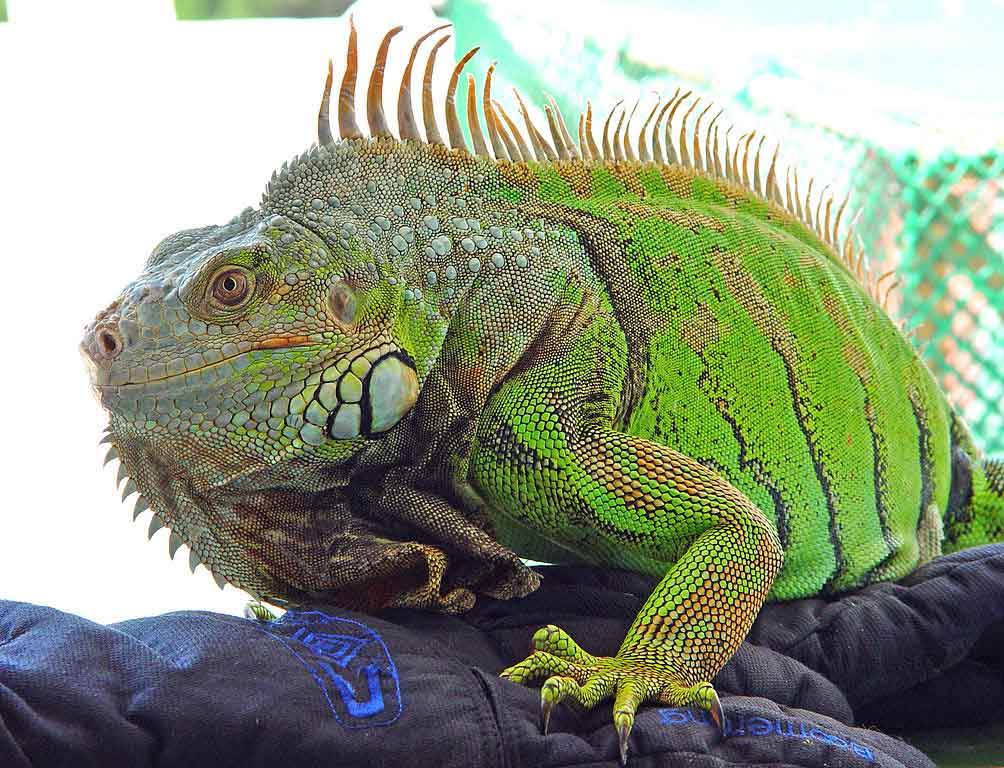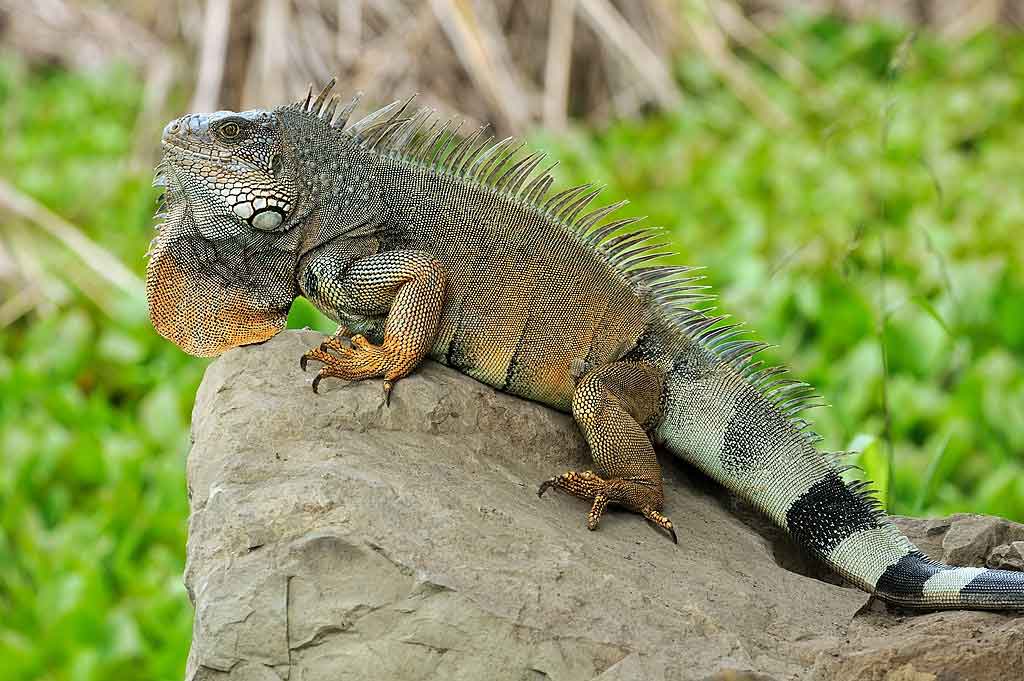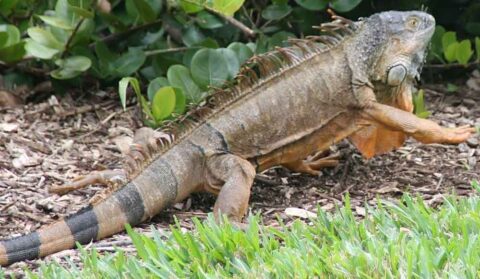
Content |
|---|
Origin / Distribution
The Green iguana (Iguana iguana) belongs to the iguana family (Iguanidae). There are two subspecies, Iguana iguana iguana and Iguana iguana rhinolopha. The latter has two or three horns on the muzzle and thus can be distinguished from the Iguana iguana. A few years ago two other subspecies of the Green iguana: Iguana iguana insularis and Iguana iguana sanctaluciae.
The native range of the Green iguana (Iguana iguana) stretches from southern Mexico to central Brazil, Paraguay and Bolivia and the Caribbean; specifically Grenada, Aruba, Curacao, Trinidad and Tobago, St. Lucia, San Vicente and Útila. They have been introduced in Grand Cayman, Puerto Rico, Hispaniola (in the Dominican Republic), Guadalupe, Texas, Florida, Hawaii and the U.S. Virgin Islands USA. It also, green iguanas colonized the island of Anguilla in 1995 after being swept away by a hurricane. Although the species is not native to Martinique, in the historic Fort of San Luis there is a small wild colony of green iguanas released or escaped.
Characteristics / Appearance
What does a Green iguana?
The Green iguana is a large reptile with a powerful body that can reach a length of almost two meters. But, the average size of a Green iguana is closer to the 1,50 m, much of which is due to its long tail. The body grows to a few 50 cm in males and some 40 cm in females. When fully developed, the Green iguana weighs about ten kilograms. With good care, They can live up to 20 years.
Young iguanas are characterized by a strong green color. With the age, green coloration decreases and becomes darker, sometimes even brown or grayish. They have a crest on the back and tail and usually have dark bands on the body and tail.. The head is characterized by a blunt snout, from which hangs a membranous gular pouch with a large jagged crest.
As inhabitants of the trees, the Green iguana can climb well. Their sharp claws also help them do that.. Diurnal animals can also swim well. As for his character, green iguanas are considered curious, sensitive and relatively confident, although, of course, they are not at all cuddly animals. If the danger threatens, the Green iguana can wag tail like lizards. Then it grows back, but it falls shorter.
Wide variety of colors
Green is not the only color that can be shown by Green iguanas. Its hue is usually bluish and can change throughout your life. Many Green Iguanass become more and more pink, brown, grey or almost black. The Green iguanas are characterized by their scaly and delicate skin. A thorny ridge runs through the back of reptiles; have a double chin under their chin.
Habitat
The natural habitat of the Green iguana are the rainforests of the lowlands, in the vicinity of large bodies of water. Populations in coastal regions with low rainfall are extremely rare.
Behavior
Animals are diurnal and spend most of their time in trees and like to bathe. Although they are considered sociable, there is usually only one adult male in a group. It is important to keep this in mind when keeping them in a terrarium., otherwise fights may occur. A Green iguana can even become meek, which is noticeable in the fact that he greets contact persons by nodding his head..
Threats to the species
State of conservation ⓘ |
||
|---|---|---|
 Minor Concern ⓘ
(UICN)ⓘ
Minor Concern ⓘ
(UICN)ⓘ
| ||
The Green iguana is included in Appendix II of the Convention on International Trade in Endangered Species of Wild Fauna and Flora (CITES), which means that international trade is regulated by the CITES permit system. It also, the Green iguana is classified as Least Concern by the IUCN, mentioning that habitat depletion by development is a potential concern for populations of Green iguana in the future. Historically, green iguana meat and eggs have been consumed as a source of protein throughout their range, and are appreciated for their supposed medicinal and aphrodisiac properties. Efforts have been made in the past to breed green iguanas in captivity as a food source in an attempt to encourage more sustainable land use in Panama and Costa Rica..
The "Green iguana" in captivity
The terrarium
- Type of terrarium Jungle or tree terrarium
- Temperature of 25 to 30 degrees Celsius during the day, 20-25 degrees Celsius at night
- Humidity High humidity
- Need for sun A sunny place per animal is required with temperatures of approximately 35 – 40 Celsius degrees.
If you want to have a Green iguana, you need a lot of space. Since these animals can reach two meters or more, a medium-sized terrarium is not enough for good conservation. Yes, you Green iguana has to live tight, won't feel comfortable with you. The minimum size of the terrarium for a Green iguana adult should be 300 x 200 x 250 centimeters. Young animals are raised in a smaller terrarium. It is important to have a sufficient height with many climbing branches so that the animals can climb. Animals like to rest on horizontal branches under a spotlight.
If several animals are housed in the same terrarium, they need enough hiding places so they don't look all the time. Thick PVC pipes into which a board or floor is inserted are suitable for this purpose. The ground should be covered with sphagnum, sawdust, linoleum or tiles. Coatings with sharp edges, such as expanded clay or gravel, are absolutely inadequate.
Even with a spacious terrarium, is controversial among terrarium enthusiasts whether the Green iguana must be kept in a terrarium in general. As an alternative, if you have the opportunity, it's a good idea to host the Green iguana in your own reptile room. As long as you can create in it the right weather conditions, this option is preferable to a large terrarium.
Temperature and humidity in the terrarium

A rainforest or tree terrarium is suitable for maintaining a Green iguana. It doesn't matter which variant you choose: Temperatures and humidity must be adequate for green iguanas to feel comfortable in them. Temperatures should range from 25 and 35 degrees during the day and at least 20 degrees at night. It also creates a warmer place where the temperature is between 40 and 45 degrees Celsius. If you have several animals in the same terrarium, each of them needs what is called a sun point.
The humidity of the terrarium should be between the 60 and the 80 percent during the day and between 80 and the 95 percent at night. Animals also need UV-B lighting for about twelve hours a day.. To adapt the climate to the natural habitat, animals and terrarium should be sprayed with water daily. During the winter period (December-April), the climate must be maintained 5 cooler and drier degrees Celsius. To avoid bacteria and mold, the terrarium should also be well ventilated.
Tips for decoration
Equip the terrarium or reptile room with enough branches and trunks to climb and rest. Branches for climbing should be at least as thick as the trunk of the lizard. Rocks are also useful, the roots and the cork caves. It is also important to have a water basin with a temperature of about 25 degrees Celsius. It is best to heat it with a bottom heater or a heater in the filter.
You can use real or artificial plants in the terrarium of your iguanas. Real plants are good for the climate, but they can be crushed or eaten. So, real plants must definitely be non-toxic. The substrate must be dry and absorbent.
Care and nutrition

So that your Green iguana stays well, prudent care is essential. Good care starts with diet. The green iguanas are vegetarian, so animal foods shouldn't be on your menu. Exceptions are young iguanas and pregnant females, whose diet should consist of a 15% of animal feed (insects and eggs).
A varied diet is important to ensure a sufficient supply of nutrients. Leafy greens should make up the main part of the diet, around the 60%. These may include, can be fed with dandelion, Canons, clover, rib or parsley grass. To the green iguanas they also like cabbage. The 40% remaining diet should consist of flowers (30%) and fruits (10%). Papaya, strawberries, mandarins or prickly pear figs are suitable. The foliage of trees is particularly greedily consumed by animals. You can supplement your diet with vitamin and mineral supplements to prevent malnutrition. Animal feed should never exceed the 5%. Its excess can cause kidney problems in animals.
Hygiene also plays an important role in maintaining green iguanas. Infestation with parasites such as mites and worms is relatively common in green iguanas. Thorough hygiene prevents pathogens and, Therefore, diseases. Remove food scraps and droppings every day, change the water daily and clean the entire terrarium regularly. Diseases that are comparatively common in green iguanas include putrefaction of the mouth, tail necrosis and intestinal and respiratory diseases.
How many green iguanas can you keep together?
In the wild, the Green iguana lives in groups consisting of one male and several females. So, you should not maintain a Green iguana individually. You can keep them in pairs or in a small group with a maximum of one male.. The latter option is more relaxed for females, since during the mating season a single female is not too harassed by the male.
It is not recommended to keep several males together. Especially dominant males do not get along with each other. Especially in the season of heat, animals have a marked territorial behavior, which can lead to bloody conflicts between males. In any case, they should only be kept together in very large terrariums with enough hiding places.
Iguanas also get along well with the turtle (Terrapene) of the warmest regions. On the other hand, the Common basilisk (Basiliscus basiliscus) wave Marine iguana (Amblyrhynchus cristatus) should not be kept together with the green iguanas. The similar appearance in terms of physique and color can cause stress in animals.
Are green iguanas suitable for beginners?
It is not the same to have a reptile in the living room of the house than a cat, a dog or rabbit. These exotic inhabitants need adequate climatic conditions and can suffer damage if poorly maintained.. Some species are so demanding that it is desirable or necessary to have previous experience in maintaining terrariums..
The green iguanas fall into this category. They are less forgiving of breeding errors than other reptiles. So, this species of iguana is not the best choice for beginners. Inadequate breeding conditions can lead to illness or premature death of the animal.
Just because of the size of the animals, you should think carefully about whether you can really meet the requirements to have green iguanas. A standard terrarium is usually not enough to keep large reptiles. Don't be dazzled by the small size of very young animals in pet stores. Must be able to offer the animal the space it needs when it has grown.
Buy one "Green iguana"
The green iguanas can be purchased from reputable breeders. Make sure the maintenance conditions are good and the animals look clean, well fed and, in general, healthy. You can also find them at a rescue center or animal shelter.. The pet shop is also a place to go, but here it is not known where the animals come from or under what conditions they have been raised.
For reasons of protection of species and the environment, you should not buy wild-caught animals, especially since they are usually in a worse state of health than the offspring.
The green iguanas cost between 50 and 100 euros per copy. Adult specimens are more expensive, just like the rarest color varieties. The costs of the terrarium and its equipment are much higher than those of the animals themselves. You also have to take into account the costs of food and electricity.
Frequently Asked Questions about the Green Iguana

How many years do green iguanas live?
Live some 10 years.
Where do green iguanas live??
Its natural habitat is in central and central South America., and prefers rainforests and savannah forests with proximity to water. In the news, the iguana is also native to some Caribbean islands and parts of Florida.
What size should a terrarium be for an iguana?
Due to its size, iguanas need very large terrariums with dimensions of approximately 300 x 200 x 250 cm..
How can I distinguish male iguanas from females??
Animals are not easy to distinguish. Male iguanas have a larger throat pouch, larger femoral pores, a thicker tail root and a wider head than females when they are between one and two years old. During the mating season, males have a red color, more intense orange or gold. They are also usually more dominant than females.
How do green iguanas reproduce??
In the wild, animals copulate at the beginning of the dry season, while in captivity they behave differently. In this case, it may be helpful to keep animals apart for a while to stimulate them. If a couple is lying next to each other, sometimes there is a vigorous courtship with head movements that is followed by a mating.
Do iguanas become meek?
If iguanas grow with human contact from an early age, they become tame and you can handle them without leather gloves. Animals that are not used to humans can react aggressively and hit with their tails., scratch with claws and bite. But, with a lot of patience, even the oldest animals can be domesticated by hand.
How are iguanas domesticated??
It is best to feed by hand the green iguanas regularly to get them used to. To feed them, you can also put them on your arm and keep them at eye level while you talk to them.. In this way, you can also show the animals to the veterinarian or move them without problems.
Videos "Green iguana"
|
|
|
|---|
Alternative names:
1. Green iguana, American iguana, Common green iguana (English).
2. Iguane vert, Iguane commun (French).
3. Grüner Leguan (German).
4. Iguana-verde, Iguana-comum, Iguano, Sinimbu, Cambaleão, Senembi, Senembu, Tijibu (Portuguese).
5. "Iguana verde", Iguana común (español).
